Legal Issues in Business Organizations: Formation and Resolution
VerifiedAdded on 2023/06/10
|12
|2661
|317
Report
AI Summary
This report provides an overview of legal issues in business organizations, focusing on the formation of different types of businesses such as sole proprietorships, partnerships, and companies, while explaining appropriate legal solutions to resolve different types of disputes. It details the advantages and disadvantages of each business structure, including sole trading, ordinary partnerships, limited partnerships, limited liability partnerships, public companies, and private companies. The report also explores alternative dispute resolution mechanisms like negotiation, mediation, conciliation, and arbitration, emphasizing their role in settling disputes outside the court system. It highlights the importance of understanding business law for governing transactions and resolving conflicts in commercial matters, referencing key legal cases and the application of corporate personality principles.
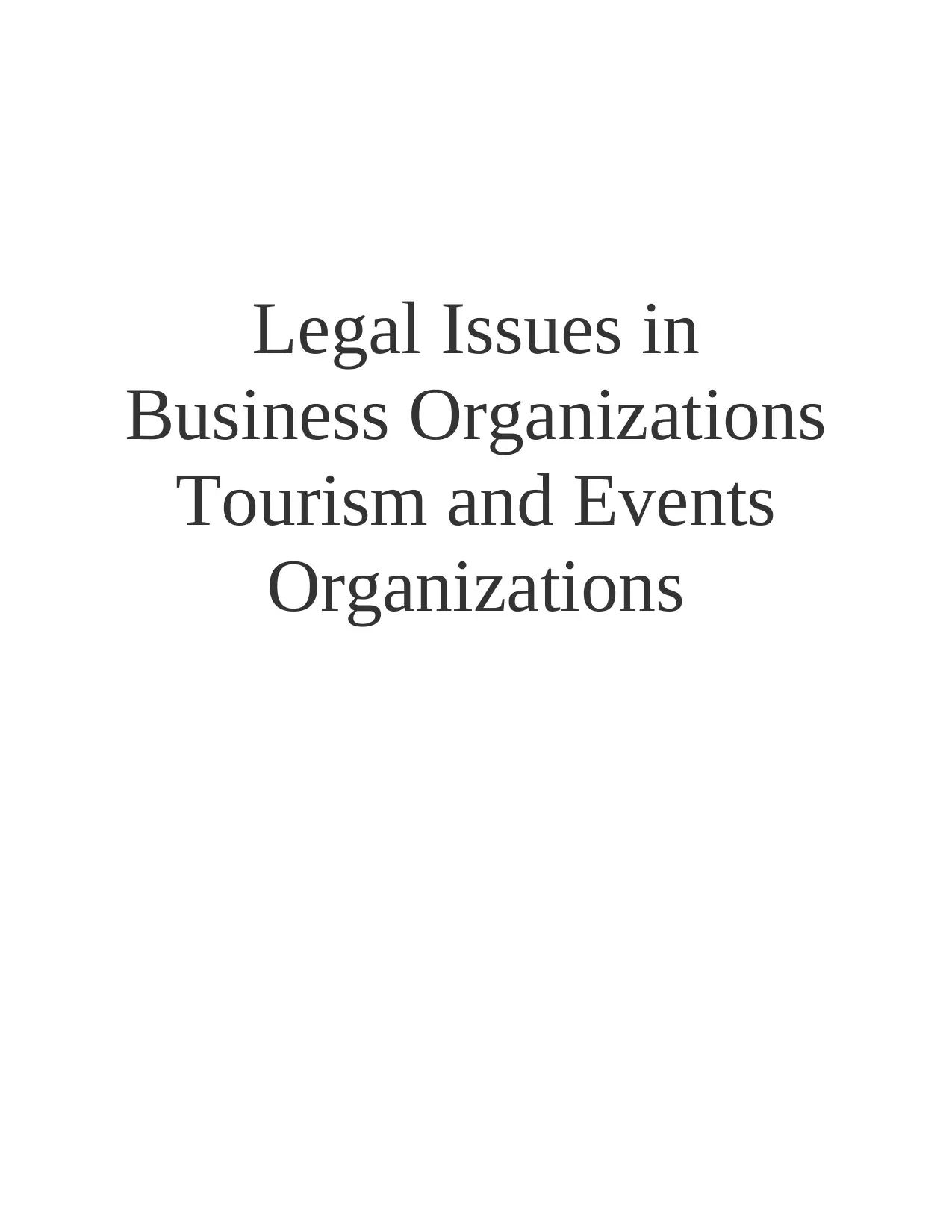
Legal Issues in
Business Organizations
Tourism and Events
Organizations
Business Organizations
Tourism and Events
Organizations
Paraphrase This Document
Need a fresh take? Get an instant paraphrase of this document with our AI Paraphraser
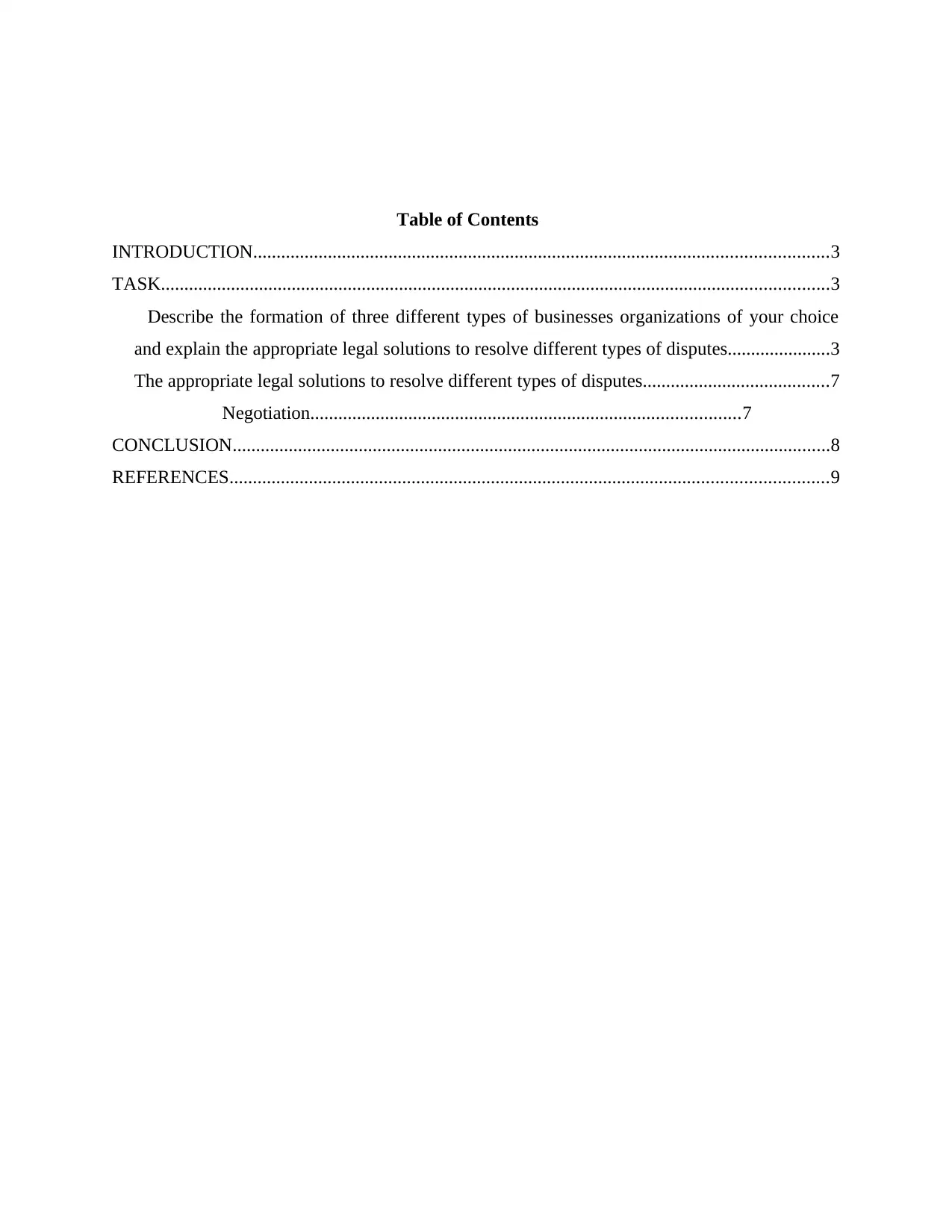
Table of Contents
INTRODUCTION...........................................................................................................................3
TASK...............................................................................................................................................3
Describe the formation of three different types of businesses organizations of your choice
and explain the appropriate legal solutions to resolve different types of disputes......................3
The appropriate legal solutions to resolve different types of disputes........................................7
Negotiation............................................................................................7
CONCLUSION................................................................................................................................8
REFERENCES................................................................................................................................9
INTRODUCTION...........................................................................................................................3
TASK...............................................................................................................................................3
Describe the formation of three different types of businesses organizations of your choice
and explain the appropriate legal solutions to resolve different types of disputes......................3
The appropriate legal solutions to resolve different types of disputes........................................7
Negotiation............................................................................................7
CONCLUSION................................................................................................................................8
REFERENCES................................................................................................................................9
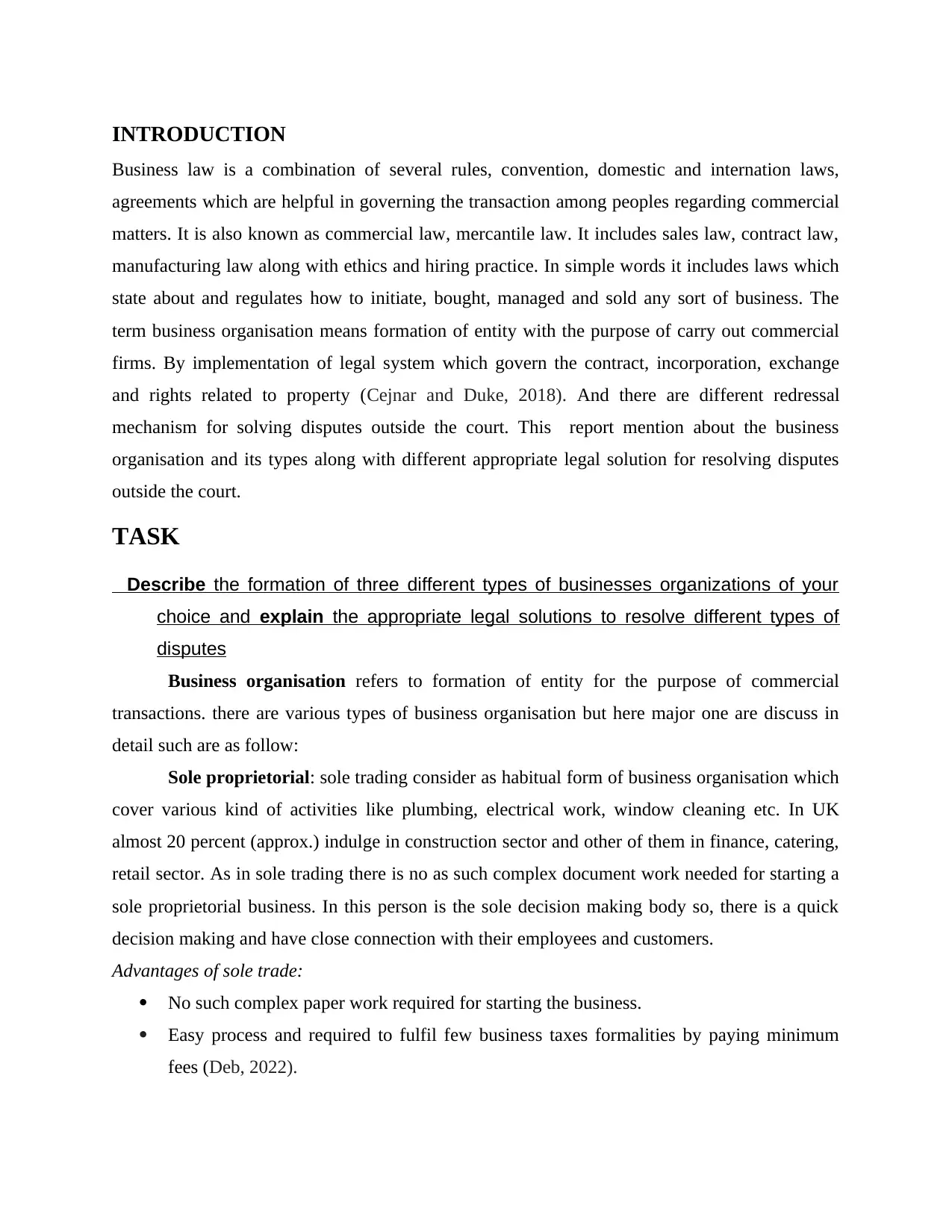
INTRODUCTION
Business law is a combination of several rules, convention, domestic and internation laws,
agreements which are helpful in governing the transaction among peoples regarding commercial
matters. It is also known as commercial law, mercantile law. It includes sales law, contract law,
manufacturing law along with ethics and hiring practice. In simple words it includes laws which
state about and regulates how to initiate, bought, managed and sold any sort of business. The
term business organisation means formation of entity with the purpose of carry out commercial
firms. By implementation of legal system which govern the contract, incorporation, exchange
and rights related to property (Cejnar and Duke, 2018). And there are different redressal
mechanism for solving disputes outside the court. This report mention about the business
organisation and its types along with different appropriate legal solution for resolving disputes
outside the court.
TASK
Describe the formation of three different types of businesses organizations of your
choice and explain the appropriate legal solutions to resolve different types of
disputes
Business organisation refers to formation of entity for the purpose of commercial
transactions. there are various types of business organisation but here major one are discuss in
detail such are as follow:
Sole proprietorial: sole trading consider as habitual form of business organisation which
cover various kind of activities like plumbing, electrical work, window cleaning etc. In UK
almost 20 percent (approx.) indulge in construction sector and other of them in finance, catering,
retail sector. As in sole trading there is no as such complex document work needed for starting a
sole proprietorial business. In this person is the sole decision making body so, there is a quick
decision making and have close connection with their employees and customers.
Advantages of sole trade:
No such complex paper work required for starting the business.
Easy process and required to fulfil few business taxes formalities by paying minimum
fees (Deb, 2022).
Business law is a combination of several rules, convention, domestic and internation laws,
agreements which are helpful in governing the transaction among peoples regarding commercial
matters. It is also known as commercial law, mercantile law. It includes sales law, contract law,
manufacturing law along with ethics and hiring practice. In simple words it includes laws which
state about and regulates how to initiate, bought, managed and sold any sort of business. The
term business organisation means formation of entity with the purpose of carry out commercial
firms. By implementation of legal system which govern the contract, incorporation, exchange
and rights related to property (Cejnar and Duke, 2018). And there are different redressal
mechanism for solving disputes outside the court. This report mention about the business
organisation and its types along with different appropriate legal solution for resolving disputes
outside the court.
TASK
Describe the formation of three different types of businesses organizations of your
choice and explain the appropriate legal solutions to resolve different types of
disputes
Business organisation refers to formation of entity for the purpose of commercial
transactions. there are various types of business organisation but here major one are discuss in
detail such are as follow:
Sole proprietorial: sole trading consider as habitual form of business organisation which
cover various kind of activities like plumbing, electrical work, window cleaning etc. In UK
almost 20 percent (approx.) indulge in construction sector and other of them in finance, catering,
retail sector. As in sole trading there is no as such complex document work needed for starting a
sole proprietorial business. In this person is the sole decision making body so, there is a quick
decision making and have close connection with their employees and customers.
Advantages of sole trade:
No such complex paper work required for starting the business.
Easy process and required to fulfil few business taxes formalities by paying minimum
fees (Deb, 2022).
⊘ This is a preview!⊘
Do you want full access?
Subscribe today to unlock all pages.

Trusted by 1+ million students worldwide
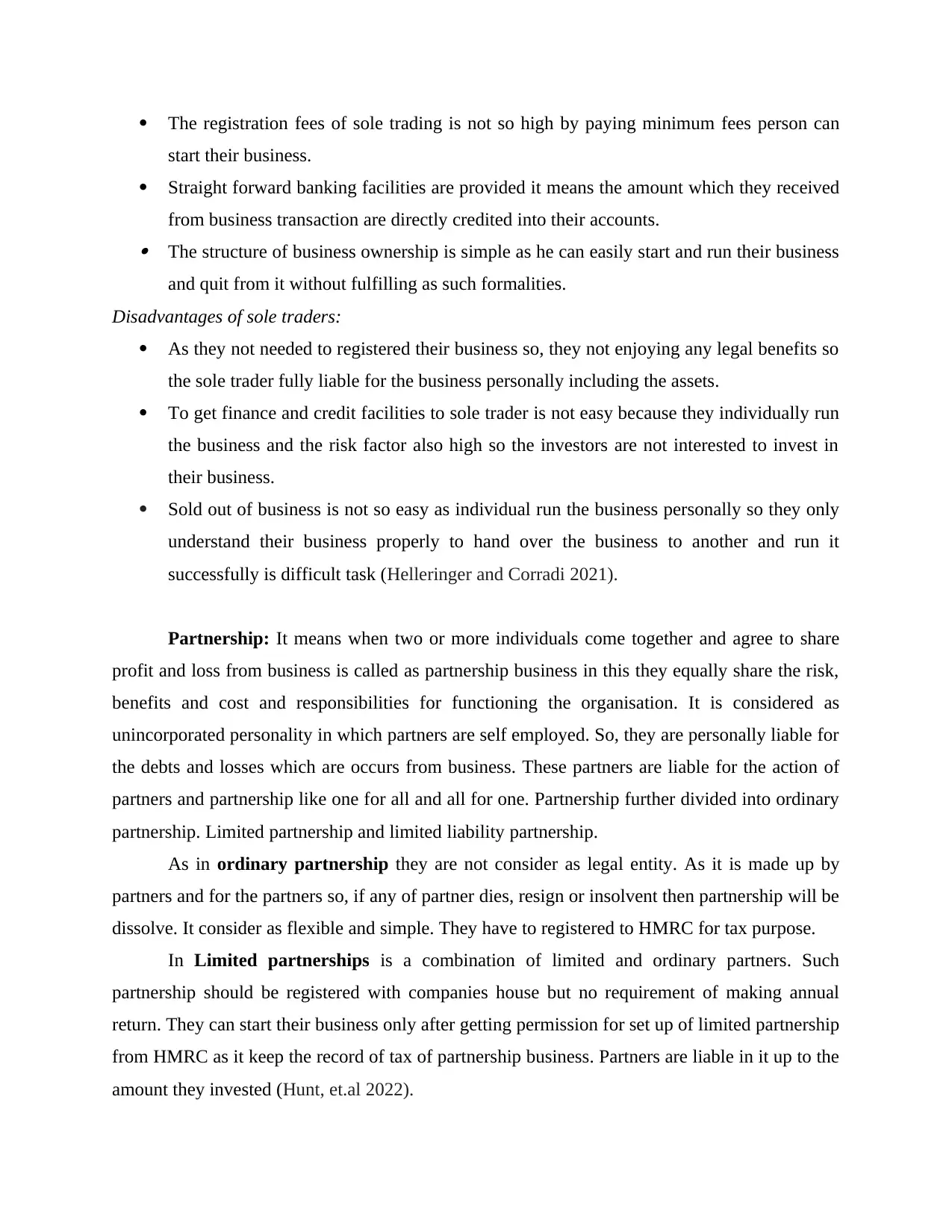
The registration fees of sole trading is not so high by paying minimum fees person can
start their business.
Straight forward banking facilities are provided it means the amount which they received
from business transaction are directly credited into their accounts. The structure of business ownership is simple as he can easily start and run their business
and quit from it without fulfilling as such formalities.
Disadvantages of sole traders:
As they not needed to registered their business so, they not enjoying any legal benefits so
the sole trader fully liable for the business personally including the assets.
To get finance and credit facilities to sole trader is not easy because they individually run
the business and the risk factor also high so the investors are not interested to invest in
their business.
Sold out of business is not so easy as individual run the business personally so they only
understand their business properly to hand over the business to another and run it
successfully is difficult task (Helleringer and Corradi 2021).
Partnership: It means when two or more individuals come together and agree to share
profit and loss from business is called as partnership business in this they equally share the risk,
benefits and cost and responsibilities for functioning the organisation. It is considered as
unincorporated personality in which partners are self employed. So, they are personally liable for
the debts and losses which are occurs from business. These partners are liable for the action of
partners and partnership like one for all and all for one. Partnership further divided into ordinary
partnership. Limited partnership and limited liability partnership.
As in ordinary partnership they are not consider as legal entity. As it is made up by
partners and for the partners so, if any of partner dies, resign or insolvent then partnership will be
dissolve. It consider as flexible and simple. They have to registered to HMRC for tax purpose.
In Limited partnerships is a combination of limited and ordinary partners. Such
partnership should be registered with companies house but no requirement of making annual
return. They can start their business only after getting permission for set up of limited partnership
from HMRC as it keep the record of tax of partnership business. Partners are liable in it up to the
amount they invested (Hunt, et.al 2022).
start their business.
Straight forward banking facilities are provided it means the amount which they received
from business transaction are directly credited into their accounts. The structure of business ownership is simple as he can easily start and run their business
and quit from it without fulfilling as such formalities.
Disadvantages of sole traders:
As they not needed to registered their business so, they not enjoying any legal benefits so
the sole trader fully liable for the business personally including the assets.
To get finance and credit facilities to sole trader is not easy because they individually run
the business and the risk factor also high so the investors are not interested to invest in
their business.
Sold out of business is not so easy as individual run the business personally so they only
understand their business properly to hand over the business to another and run it
successfully is difficult task (Helleringer and Corradi 2021).
Partnership: It means when two or more individuals come together and agree to share
profit and loss from business is called as partnership business in this they equally share the risk,
benefits and cost and responsibilities for functioning the organisation. It is considered as
unincorporated personality in which partners are self employed. So, they are personally liable for
the debts and losses which are occurs from business. These partners are liable for the action of
partners and partnership like one for all and all for one. Partnership further divided into ordinary
partnership. Limited partnership and limited liability partnership.
As in ordinary partnership they are not consider as legal entity. As it is made up by
partners and for the partners so, if any of partner dies, resign or insolvent then partnership will be
dissolve. It consider as flexible and simple. They have to registered to HMRC for tax purpose.
In Limited partnerships is a combination of limited and ordinary partners. Such
partnership should be registered with companies house but no requirement of making annual
return. They can start their business only after getting permission for set up of limited partnership
from HMRC as it keep the record of tax of partnership business. Partners are liable in it up to the
amount they invested (Hunt, et.al 2022).
Paraphrase This Document
Need a fresh take? Get an instant paraphrase of this document with our AI Paraphraser
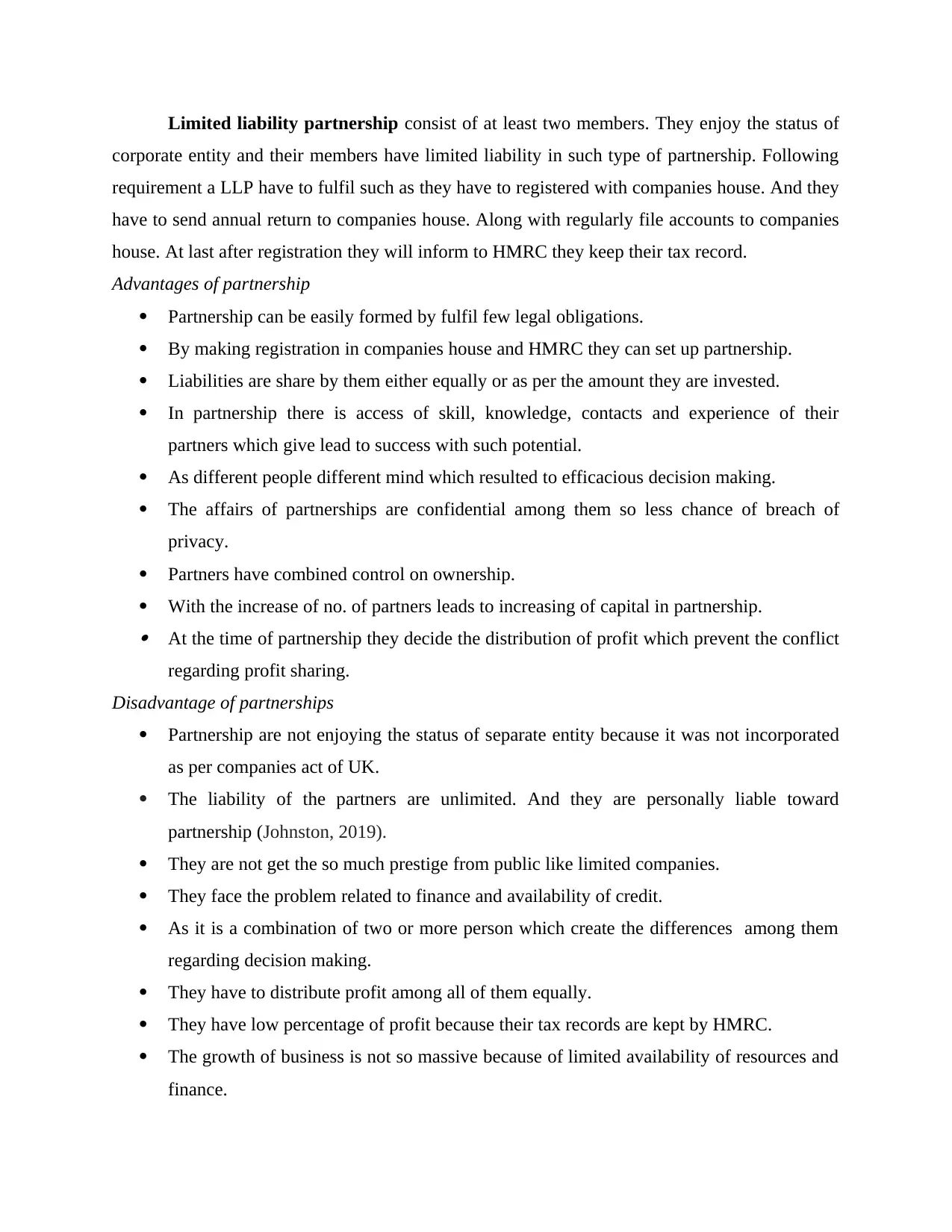
Limited liability partnership consist of at least two members. They enjoy the status of
corporate entity and their members have limited liability in such type of partnership. Following
requirement a LLP have to fulfil such as they have to registered with companies house. And they
have to send annual return to companies house. Along with regularly file accounts to companies
house. At last after registration they will inform to HMRC they keep their tax record.
Advantages of partnership
Partnership can be easily formed by fulfil few legal obligations.
By making registration in companies house and HMRC they can set up partnership.
Liabilities are share by them either equally or as per the amount they are invested.
In partnership there is access of skill, knowledge, contacts and experience of their
partners which give lead to success with such potential.
As different people different mind which resulted to efficacious decision making.
The affairs of partnerships are confidential among them so less chance of breach of
privacy.
Partners have combined control on ownership.
With the increase of no. of partners leads to increasing of capital in partnership. At the time of partnership they decide the distribution of profit which prevent the conflict
regarding profit sharing.
Disadvantage of partnerships
Partnership are not enjoying the status of separate entity because it was not incorporated
as per companies act of UK.
The liability of the partners are unlimited. And they are personally liable toward
partnership (Johnston, 2019).
They are not get the so much prestige from public like limited companies.
They face the problem related to finance and availability of credit.
As it is a combination of two or more person which create the differences among them
regarding decision making.
They have to distribute profit among all of them equally.
They have low percentage of profit because their tax records are kept by HMRC.
The growth of business is not so massive because of limited availability of resources and
finance.
corporate entity and their members have limited liability in such type of partnership. Following
requirement a LLP have to fulfil such as they have to registered with companies house. And they
have to send annual return to companies house. Along with regularly file accounts to companies
house. At last after registration they will inform to HMRC they keep their tax record.
Advantages of partnership
Partnership can be easily formed by fulfil few legal obligations.
By making registration in companies house and HMRC they can set up partnership.
Liabilities are share by them either equally or as per the amount they are invested.
In partnership there is access of skill, knowledge, contacts and experience of their
partners which give lead to success with such potential.
As different people different mind which resulted to efficacious decision making.
The affairs of partnerships are confidential among them so less chance of breach of
privacy.
Partners have combined control on ownership.
With the increase of no. of partners leads to increasing of capital in partnership. At the time of partnership they decide the distribution of profit which prevent the conflict
regarding profit sharing.
Disadvantage of partnerships
Partnership are not enjoying the status of separate entity because it was not incorporated
as per companies act of UK.
The liability of the partners are unlimited. And they are personally liable toward
partnership (Johnston, 2019).
They are not get the so much prestige from public like limited companies.
They face the problem related to finance and availability of credit.
As it is a combination of two or more person which create the differences among them
regarding decision making.
They have to distribute profit among all of them equally.
They have low percentage of profit because their tax records are kept by HMRC.
The growth of business is not so massive because of limited availability of resources and
finance.
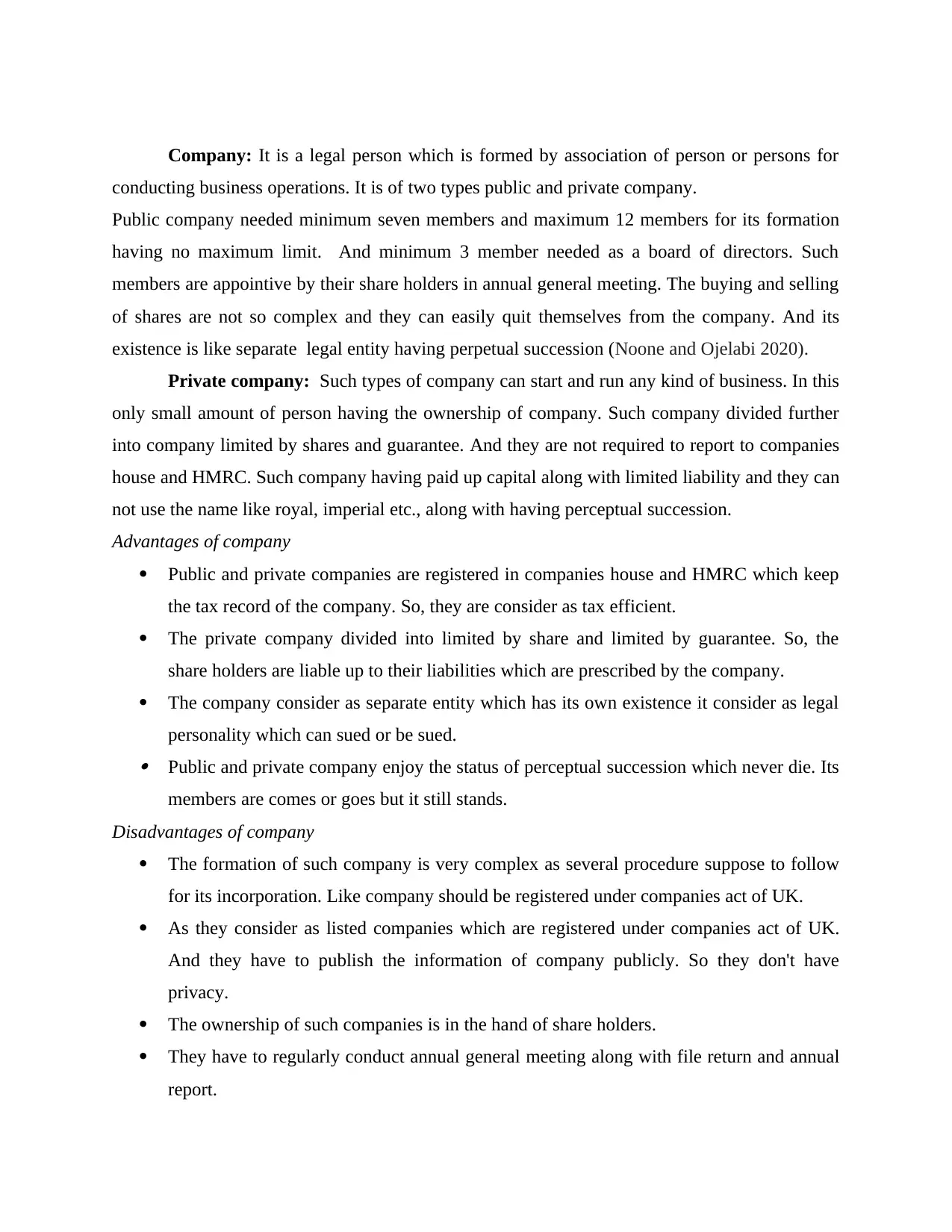
Company: It is a legal person which is formed by association of person or persons for
conducting business operations. It is of two types public and private company.
Public company needed minimum seven members and maximum 12 members for its formation
having no maximum limit. And minimum 3 member needed as a board of directors. Such
members are appointive by their share holders in annual general meeting. The buying and selling
of shares are not so complex and they can easily quit themselves from the company. And its
existence is like separate legal entity having perpetual succession (Noone and Ojelabi 2020).
Private company: Such types of company can start and run any kind of business. In this
only small amount of person having the ownership of company. Such company divided further
into company limited by shares and guarantee. And they are not required to report to companies
house and HMRC. Such company having paid up capital along with limited liability and they can
not use the name like royal, imperial etc., along with having perceptual succession.
Advantages of company
Public and private companies are registered in companies house and HMRC which keep
the tax record of the company. So, they are consider as tax efficient.
The private company divided into limited by share and limited by guarantee. So, the
share holders are liable up to their liabilities which are prescribed by the company.
The company consider as separate entity which has its own existence it consider as legal
personality which can sued or be sued. Public and private company enjoy the status of perceptual succession which never die. Its
members are comes or goes but it still stands.
Disadvantages of company
The formation of such company is very complex as several procedure suppose to follow
for its incorporation. Like company should be registered under companies act of UK.
As they consider as listed companies which are registered under companies act of UK.
And they have to publish the information of company publicly. So they don't have
privacy.
The ownership of such companies is in the hand of share holders.
They have to regularly conduct annual general meeting along with file return and annual
report.
conducting business operations. It is of two types public and private company.
Public company needed minimum seven members and maximum 12 members for its formation
having no maximum limit. And minimum 3 member needed as a board of directors. Such
members are appointive by their share holders in annual general meeting. The buying and selling
of shares are not so complex and they can easily quit themselves from the company. And its
existence is like separate legal entity having perpetual succession (Noone and Ojelabi 2020).
Private company: Such types of company can start and run any kind of business. In this
only small amount of person having the ownership of company. Such company divided further
into company limited by shares and guarantee. And they are not required to report to companies
house and HMRC. Such company having paid up capital along with limited liability and they can
not use the name like royal, imperial etc., along with having perceptual succession.
Advantages of company
Public and private companies are registered in companies house and HMRC which keep
the tax record of the company. So, they are consider as tax efficient.
The private company divided into limited by share and limited by guarantee. So, the
share holders are liable up to their liabilities which are prescribed by the company.
The company consider as separate entity which has its own existence it consider as legal
personality which can sued or be sued. Public and private company enjoy the status of perceptual succession which never die. Its
members are comes or goes but it still stands.
Disadvantages of company
The formation of such company is very complex as several procedure suppose to follow
for its incorporation. Like company should be registered under companies act of UK.
As they consider as listed companies which are registered under companies act of UK.
And they have to publish the information of company publicly. So they don't have
privacy.
The ownership of such companies is in the hand of share holders.
They have to regularly conduct annual general meeting along with file return and annual
report.
⊘ This is a preview!⊘
Do you want full access?
Subscribe today to unlock all pages.

Trusted by 1+ million students worldwide
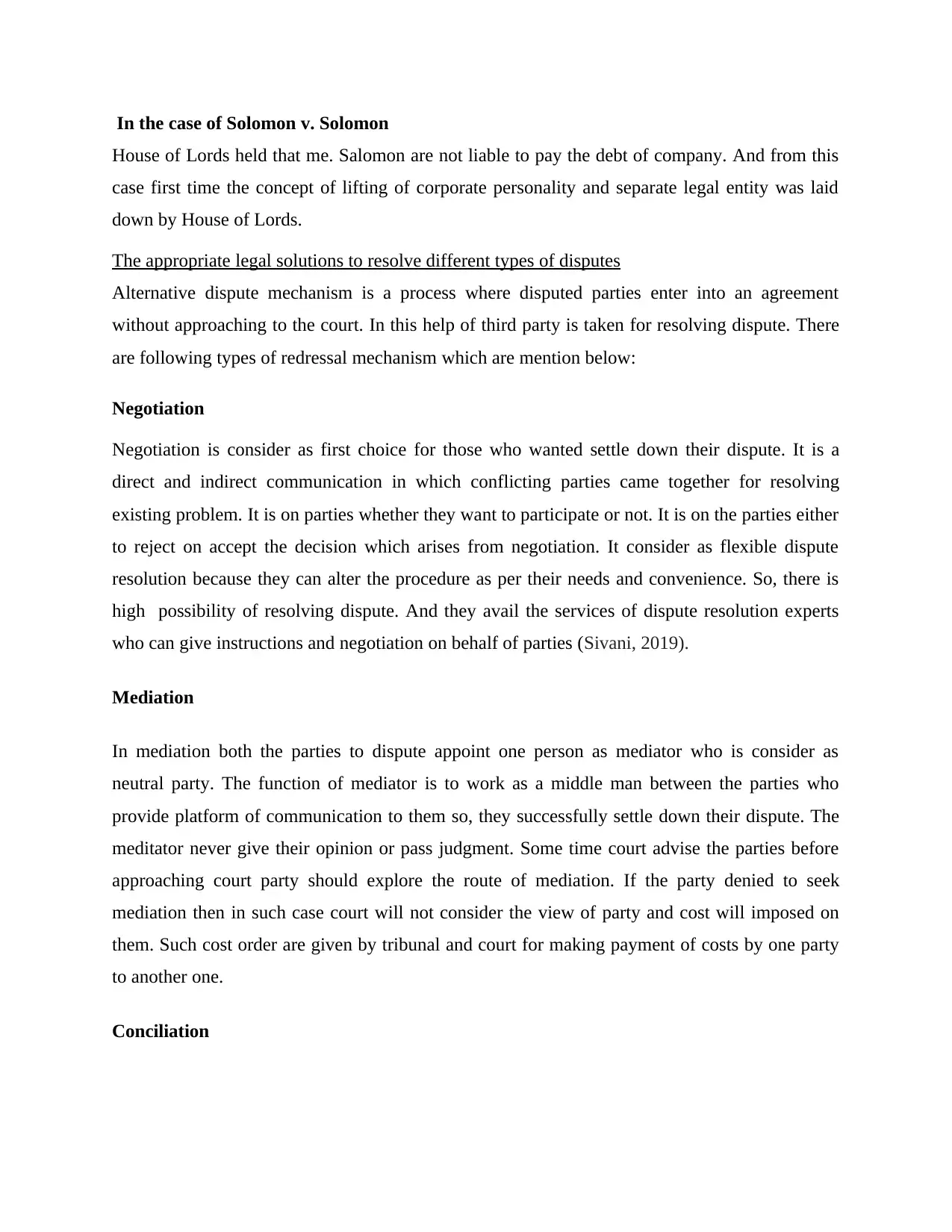
In the case of Solomon v. Solomon
House of Lords held that me. Salomon are not liable to pay the debt of company. And from this
case first time the concept of lifting of corporate personality and separate legal entity was laid
down by House of Lords.
The appropriate legal solutions to resolve different types of disputes
Alternative dispute mechanism is a process where disputed parties enter into an agreement
without approaching to the court. In this help of third party is taken for resolving dispute. There
are following types of redressal mechanism which are mention below:
Negotiation
Negotiation is consider as first choice for those who wanted settle down their dispute. It is a
direct and indirect communication in which conflicting parties came together for resolving
existing problem. It is on parties whether they want to participate or not. It is on the parties either
to reject on accept the decision which arises from negotiation. It consider as flexible dispute
resolution because they can alter the procedure as per their needs and convenience. So, there is
high possibility of resolving dispute. And they avail the services of dispute resolution experts
who can give instructions and negotiation on behalf of parties (Sivani, 2019).
Mediation
In mediation both the parties to dispute appoint one person as mediator who is consider as
neutral party. The function of mediator is to work as a middle man between the parties who
provide platform of communication to them so, they successfully settle down their dispute. The
meditator never give their opinion or pass judgment. Some time court advise the parties before
approaching court party should explore the route of mediation. If the party denied to seek
mediation then in such case court will not consider the view of party and cost will imposed on
them. Such cost order are given by tribunal and court for making payment of costs by one party
to another one.
Conciliation
House of Lords held that me. Salomon are not liable to pay the debt of company. And from this
case first time the concept of lifting of corporate personality and separate legal entity was laid
down by House of Lords.
The appropriate legal solutions to resolve different types of disputes
Alternative dispute mechanism is a process where disputed parties enter into an agreement
without approaching to the court. In this help of third party is taken for resolving dispute. There
are following types of redressal mechanism which are mention below:
Negotiation
Negotiation is consider as first choice for those who wanted settle down their dispute. It is a
direct and indirect communication in which conflicting parties came together for resolving
existing problem. It is on parties whether they want to participate or not. It is on the parties either
to reject on accept the decision which arises from negotiation. It consider as flexible dispute
resolution because they can alter the procedure as per their needs and convenience. So, there is
high possibility of resolving dispute. And they avail the services of dispute resolution experts
who can give instructions and negotiation on behalf of parties (Sivani, 2019).
Mediation
In mediation both the parties to dispute appoint one person as mediator who is consider as
neutral party. The function of mediator is to work as a middle man between the parties who
provide platform of communication to them so, they successfully settle down their dispute. The
meditator never give their opinion or pass judgment. Some time court advise the parties before
approaching court party should explore the route of mediation. If the party denied to seek
mediation then in such case court will not consider the view of party and cost will imposed on
them. Such cost order are given by tribunal and court for making payment of costs by one party
to another one.
Conciliation
Paraphrase This Document
Need a fresh take? Get an instant paraphrase of this document with our AI Paraphraser
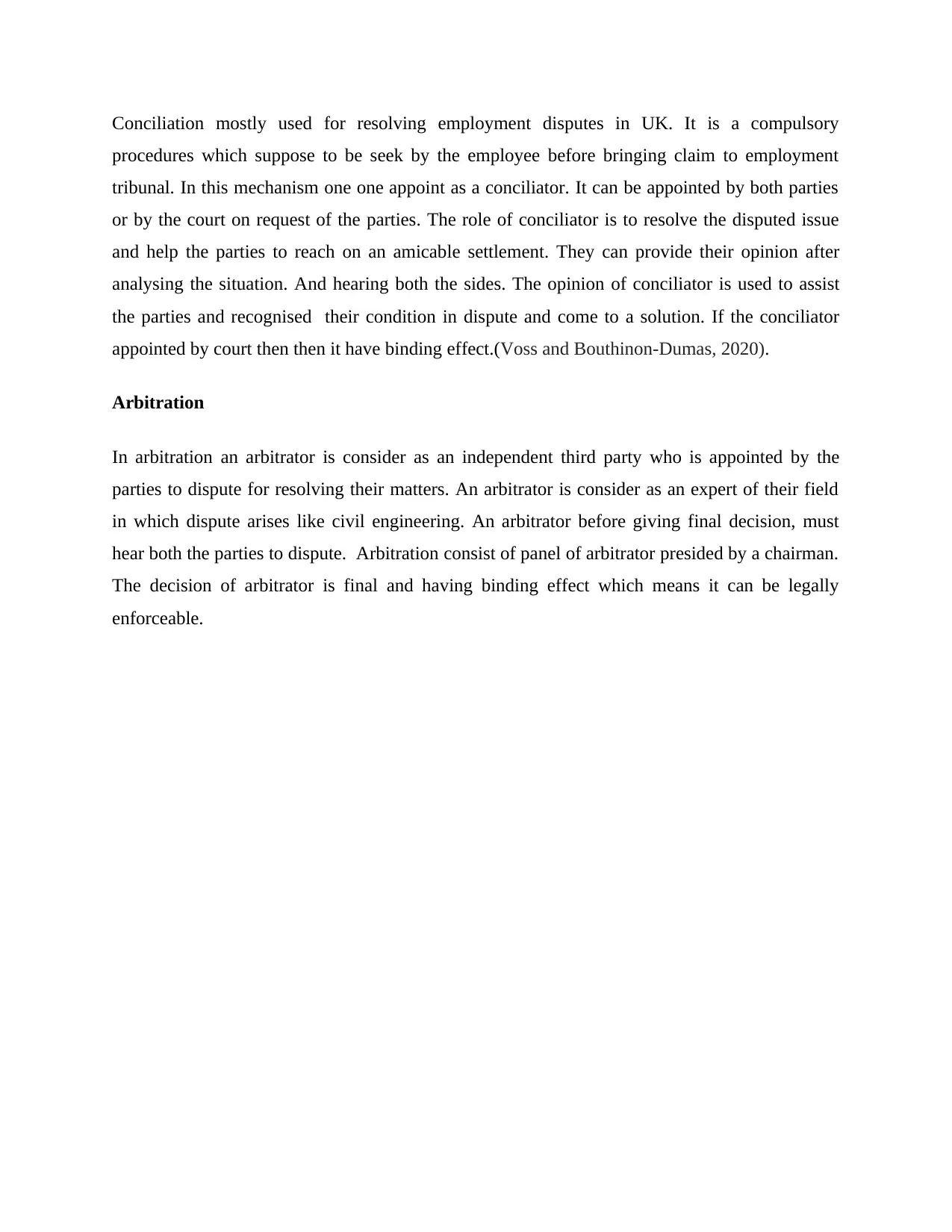
Conciliation mostly used for resolving employment disputes in UK. It is a compulsory
procedures which suppose to be seek by the employee before bringing claim to employment
tribunal. In this mechanism one one appoint as a conciliator. It can be appointed by both parties
or by the court on request of the parties. The role of conciliator is to resolve the disputed issue
and help the parties to reach on an amicable settlement. They can provide their opinion after
analysing the situation. And hearing both the sides. The opinion of conciliator is used to assist
the parties and recognised their condition in dispute and come to a solution. If the conciliator
appointed by court then then it have binding effect.(Voss and Bouthinon-Dumas, 2020).
Arbitration
In arbitration an arbitrator is consider as an independent third party who is appointed by the
parties to dispute for resolving their matters. An arbitrator is consider as an expert of their field
in which dispute arises like civil engineering. An arbitrator before giving final decision, must
hear both the parties to dispute. Arbitration consist of panel of arbitrator presided by a chairman.
The decision of arbitrator is final and having binding effect which means it can be legally
enforceable.
procedures which suppose to be seek by the employee before bringing claim to employment
tribunal. In this mechanism one one appoint as a conciliator. It can be appointed by both parties
or by the court on request of the parties. The role of conciliator is to resolve the disputed issue
and help the parties to reach on an amicable settlement. They can provide their opinion after
analysing the situation. And hearing both the sides. The opinion of conciliator is used to assist
the parties and recognised their condition in dispute and come to a solution. If the conciliator
appointed by court then then it have binding effect.(Voss and Bouthinon-Dumas, 2020).
Arbitration
In arbitration an arbitrator is consider as an independent third party who is appointed by the
parties to dispute for resolving their matters. An arbitrator is consider as an expert of their field
in which dispute arises like civil engineering. An arbitrator before giving final decision, must
hear both the parties to dispute. Arbitration consist of panel of arbitrator presided by a chairman.
The decision of arbitrator is final and having binding effect which means it can be legally
enforceable.
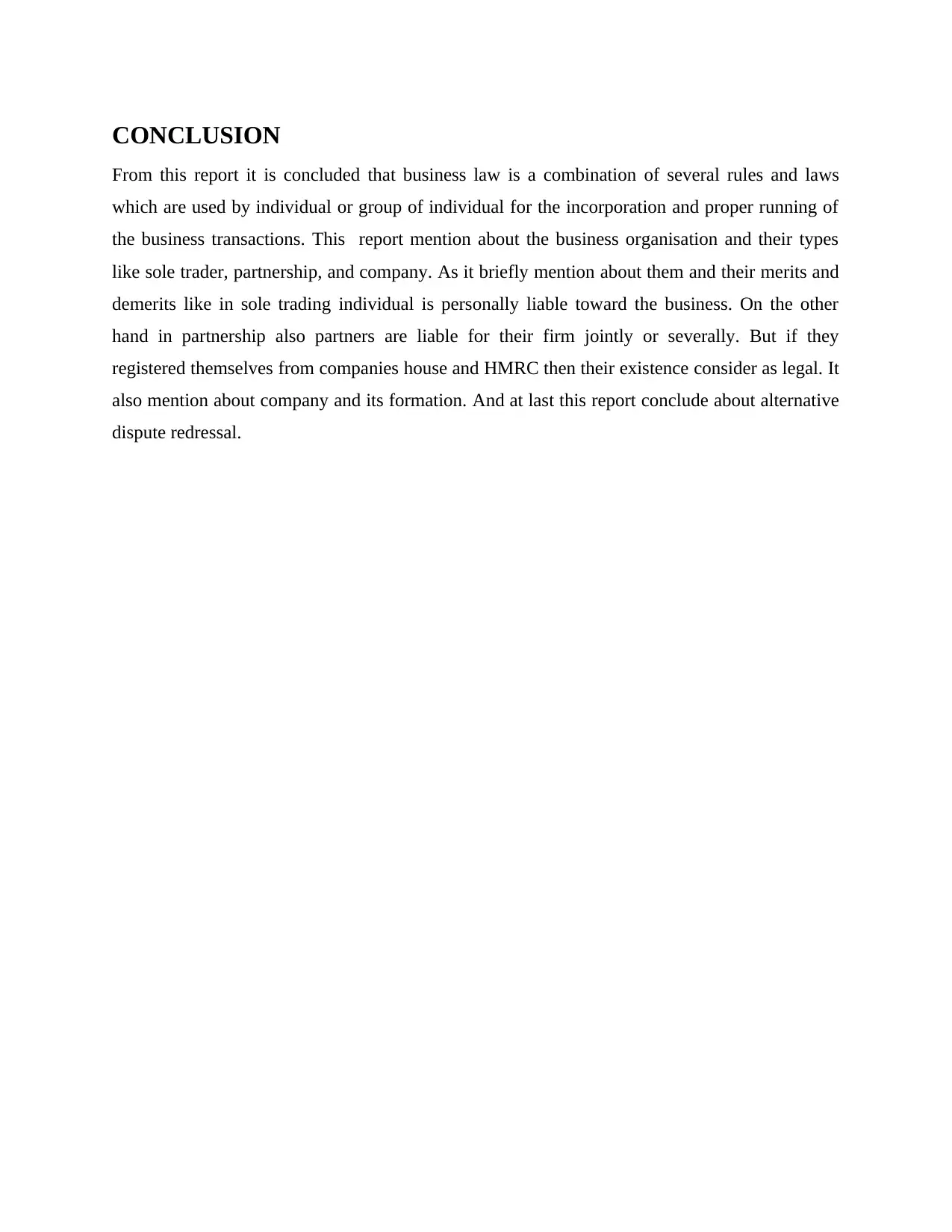
CONCLUSION
From this report it is concluded that business law is a combination of several rules and laws
which are used by individual or group of individual for the incorporation and proper running of
the business transactions. This report mention about the business organisation and their types
like sole trader, partnership, and company. As it briefly mention about them and their merits and
demerits like in sole trading individual is personally liable toward the business. On the other
hand in partnership also partners are liable for their firm jointly or severally. But if they
registered themselves from companies house and HMRC then their existence consider as legal. It
also mention about company and its formation. And at last this report conclude about alternative
dispute redressal.
From this report it is concluded that business law is a combination of several rules and laws
which are used by individual or group of individual for the incorporation and proper running of
the business transactions. This report mention about the business organisation and their types
like sole trader, partnership, and company. As it briefly mention about them and their merits and
demerits like in sole trading individual is personally liable toward the business. On the other
hand in partnership also partners are liable for their firm jointly or severally. But if they
registered themselves from companies house and HMRC then their existence consider as legal. It
also mention about company and its formation. And at last this report conclude about alternative
dispute redressal.
⊘ This is a preview!⊘
Do you want full access?
Subscribe today to unlock all pages.

Trusted by 1+ million students worldwide
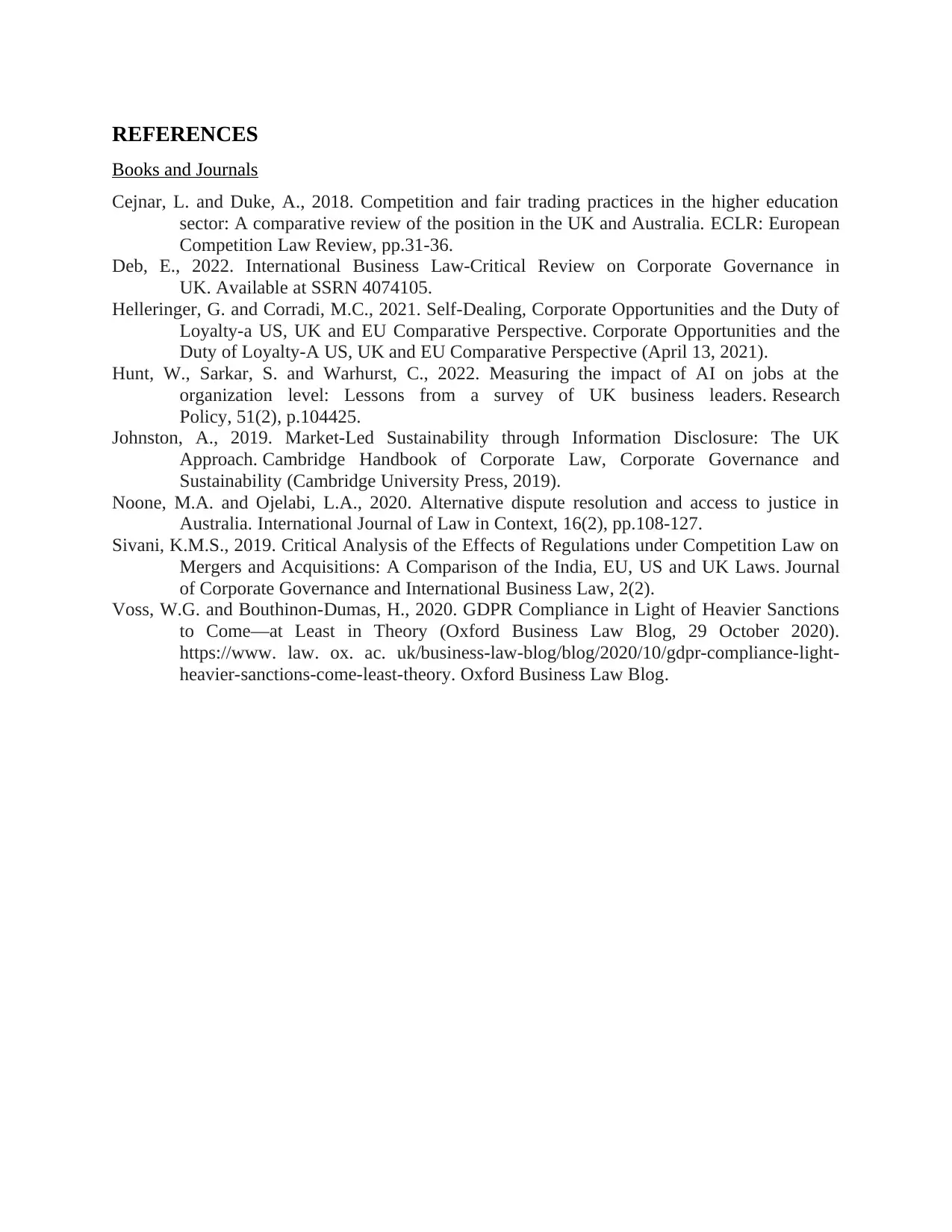
REFERENCES
Books and Journals
Cejnar, L. and Duke, A., 2018. Competition and fair trading practices in the higher education
sector: A comparative review of the position in the UK and Australia. ECLR: European
Competition Law Review, pp.31-36.
Deb, E., 2022. International Business Law-Critical Review on Corporate Governance in
UK. Available at SSRN 4074105.
Helleringer, G. and Corradi, M.C., 2021. Self-Dealing, Corporate Opportunities and the Duty of
Loyalty-a US, UK and EU Comparative Perspective. Corporate Opportunities and the
Duty of Loyalty-A US, UK and EU Comparative Perspective (April 13, 2021).
Hunt, W., Sarkar, S. and Warhurst, C., 2022. Measuring the impact of AI on jobs at the
organization level: Lessons from a survey of UK business leaders. Research
Policy, 51(2), p.104425.
Johnston, A., 2019. Market-Led Sustainability through Information Disclosure: The UK
Approach. Cambridge Handbook of Corporate Law, Corporate Governance and
Sustainability (Cambridge University Press, 2019).
Noone, M.A. and Ojelabi, L.A., 2020. Alternative dispute resolution and access to justice in
Australia. International Journal of Law in Context, 16(2), pp.108-127.
Sivani, K.M.S., 2019. Critical Analysis of the Effects of Regulations under Competition Law on
Mergers and Acquisitions: A Comparison of the India, EU, US and UK Laws. Journal
of Corporate Governance and International Business Law, 2(2).
Voss, W.G. and Bouthinon-Dumas, H., 2020. GDPR Compliance in Light of Heavier Sanctions
to Come—at Least in Theory (Oxford Business Law Blog, 29 October 2020).
https://www. law. ox. ac. uk/business-law-blog/blog/2020/10/gdpr-compliance-light-
heavier-sanctions-come-least-theory. Oxford Business Law Blog.
Books and Journals
Cejnar, L. and Duke, A., 2018. Competition and fair trading practices in the higher education
sector: A comparative review of the position in the UK and Australia. ECLR: European
Competition Law Review, pp.31-36.
Deb, E., 2022. International Business Law-Critical Review on Corporate Governance in
UK. Available at SSRN 4074105.
Helleringer, G. and Corradi, M.C., 2021. Self-Dealing, Corporate Opportunities and the Duty of
Loyalty-a US, UK and EU Comparative Perspective. Corporate Opportunities and the
Duty of Loyalty-A US, UK and EU Comparative Perspective (April 13, 2021).
Hunt, W., Sarkar, S. and Warhurst, C., 2022. Measuring the impact of AI on jobs at the
organization level: Lessons from a survey of UK business leaders. Research
Policy, 51(2), p.104425.
Johnston, A., 2019. Market-Led Sustainability through Information Disclosure: The UK
Approach. Cambridge Handbook of Corporate Law, Corporate Governance and
Sustainability (Cambridge University Press, 2019).
Noone, M.A. and Ojelabi, L.A., 2020. Alternative dispute resolution and access to justice in
Australia. International Journal of Law in Context, 16(2), pp.108-127.
Sivani, K.M.S., 2019. Critical Analysis of the Effects of Regulations under Competition Law on
Mergers and Acquisitions: A Comparison of the India, EU, US and UK Laws. Journal
of Corporate Governance and International Business Law, 2(2).
Voss, W.G. and Bouthinon-Dumas, H., 2020. GDPR Compliance in Light of Heavier Sanctions
to Come—at Least in Theory (Oxford Business Law Blog, 29 October 2020).
https://www. law. ox. ac. uk/business-law-blog/blog/2020/10/gdpr-compliance-light-
heavier-sanctions-come-least-theory. Oxford Business Law Blog.
Paraphrase This Document
Need a fresh take? Get an instant paraphrase of this document with our AI Paraphraser


⊘ This is a preview!⊘
Do you want full access?
Subscribe today to unlock all pages.

Trusted by 1+ million students worldwide
1 out of 12
Related Documents
Your All-in-One AI-Powered Toolkit for Academic Success.
+13062052269
info@desklib.com
Available 24*7 on WhatsApp / Email
![[object Object]](/_next/static/media/star-bottom.7253800d.svg)
Unlock your academic potential
Copyright © 2020–2025 A2Z Services. All Rights Reserved. Developed and managed by ZUCOL.





